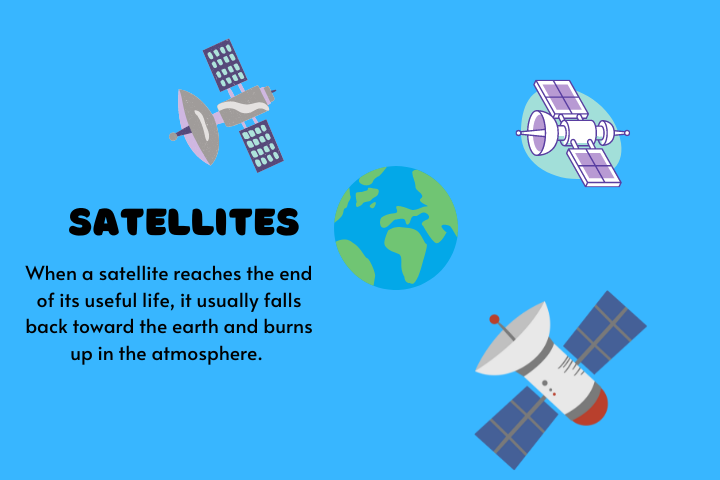Chances are you’ve seen a satellite before. They’re those little dots of light that move across the night sky. But what exactly are satellites? And what do they do? Here are 10 interesting facts about satellites that will help you better understand these fascinating objects.

- Satellites are man-made objects that orbit Earth. They come in all shapes and sizes, from the tiny Sputnik 1 to the massive International Space Station. Satellites play an important role in our lives, providing us with communications, navigation, and weather information.
- Most satellites are launched into space by rockets, which are the most powerful engines available. They work by providing a lot of thrust in a very short amount of time, which is necessary to escape the Earth’s gravitational pull. Rockets have been used for centuries, and their basic principles have remained the same.
- There are two main types of satellites: communications satellites and weather satellites. Communications satellites relay signals from one place to another, such as television or telephone signals. Weather satellites collect data about the Earth’s atmosphere, such as temperature and moisture levels.
- On October 4, 1957, the Soviet Union launched Sputnik 1, the world’s first satellite. The event marked a major turning point in the Cold War, as the United States suddenly realized that it was behind the Soviets in the race to develop space-based weapons. The first Sputnik, in addition to its radio equipment, was powered by batteries.
- On January 31, 1958, the United States launched Explorer 1, its first satellite. The successful launch was a watershed moment in the Space Race, as it proved that the United States had the technology to compete with the Soviet Union in the exploration of space. Explorer 1 was a small satellite, weighing just over 30 pounds. It carried a scientific instrument known as a Geiger counter, which was used to measure radiation levels in space.
- Satellites also have a dark side. Satellites can be used for surveillance, and their use has been linked to human rights abuses. They can also be used as weapons, as was demonstrated by the United States during the Gulf War.
- What many people don’t realize is that satellites travel at incredible speeds. For example, some satellites travel at 18,000 miles per hour, which means they can travel the entire circumference of the Earth about 14 times a day. Such high speeds are necessary to keep satellites in orbit and prevent them from crashing into the Earth.
- William Kampiles had always dreamed of working for the CIA. So when he was approached by a Russian agent and offered $3000 for a top-secret KH-11 spy satellite manual, he didn’t hesitate. He stole the manual from the CIA and sold it to the Russians. But his dream of becoming a double agent quickly turned into a nightmare. The CIA was furious, and Kampiles was sentenced to 40 years in prison.
- On July 11, 1979, the Skylab satellite came crashing down to Earth in Western Australia, scattering debris over a large area. The Australian government was not amused. In fact, they issued a fine of $400 to the US government for littering. NASA didn’t bother to pay the fine. This incident caused a lot of public outcry in Australia. People were outraged that the US would be so careless as to allow their satellite to fall from the sky and create such a mess.
- In 2005, the city of DISH, Texas struck a deal with the satellite television company Dish Network. In exchange for changing its name to “DISH, Texas” and agreeing to fly the Dish Network flag above City Hall, the company would provide free Dish Satellite service to all residents for 10 years. The agreement was a win-win for both parties: the city got free TV, and Dish Network got valuable marketing exposure.
- Over 2,500. That’s the number of satellites currently orbiting the Earth, beaming down everything from GPS directions to high-definition TV. And that number is only going to increase in the years to come.
- The International Space Station (ISS) is the largest artificial satellite to ever be built. It is truly a remarkable feat of engineering, and it has been an international effort from the very beginning. The ISS has a mass of around 450,000 kilograms, and it is currently home to a six-person crew.
- Vanguard-1 is a true pioneer of space exploration. It was the very first satellite to have solar electric power, and it has been orbiting Earth for an incredible 62 years. In that time, it has seen humanity achieve some amazing feats, from putting a man on the Moon to sending probes to distant planets. But Vanguard-1 is more than just a witness to history; it is also a valuable research tool.
- In 1998, the world was a very different place. Pagers were still widely used, and people relied on them to stay connected. So when one satellite failed and caused 80% of the world’s pagers to stop working, it was a major problem. People were stranded, unable to communicate with loved ones or get help in an emergency. The incident highlights the importance of redundancy in communication systems.
- As anyone who has ever seen a sci-fi movie knows, there is a lot of junk floating around in space. This so-called “space junk” is actually defunct satellites and other man-made objects that are no longer functioning but continue to orbit the earth. While some of this space junk eventually falls back to earth and burns up in the atmosphere, much of it remains in orbit, posing a serious threat to active satellites and even the International Space Station.
- With a working life of only 10-15 years, these satellites are constantly being replaced, resulting in an ever-increasing amount of space junk. And since it costs a lot of money to launch a satellite, there is little incentive to bring them back down to earth when they stop working. As a result, the problem of space junk is likely to continue to grow in the coming years.
Satellites are amazing feats of engineering and have revolutionized the way we communicate and understand our planet. The next time you see one streaking across the night sky, remember these 10 fascinating facts!





